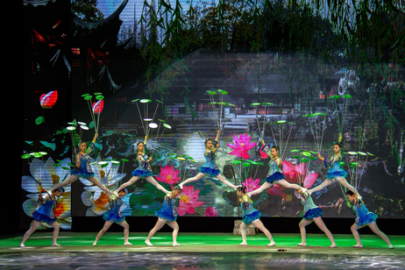by Cate Bradley, PhD
 Photo by Nick Fewings on Unsplash
Photo by Nick Fewings on Unsplash
In 2018 the circus came to my town! No animals, just unbelievable athletics, gymnastics, sleight of hand, optical illusions and futuristic computer graphics and technology – all part of the show. It was a promo for the 2020 Olympics in Tokyo. So, the evening was filled with universal communication that broke through language barriers and delighted all the social profile boxes that were represented in the audience. It was some of the best entertainment I’ve ever enjoyed.
These elite performers had a way of capturing the entire audience. You could feel the tension when they attempted unbelievable jumps at heights and strengths that almost defied human ability. We moaned when they missed the first attempt at the highest jump through the ring. Afterwards I realized it was always a piece of cake to them, they just didn’t want us taking it for granted. I can only imagine the hours of pain, discouragement, blood, sweat and tears invested in perfecting each of the acts that kept us wanting more. We always want more, don’t we?
One act that challenged physics was the plate spinning feat. Two of the troupe came on stage to ultimately spin a dozen or more plates on thin poles. One fed the plate to the other who kept his eyes on the top of the thin pole which would receive the plate. The set spanned about twenty feet or so. The second troupe member moved in union with the spinner. They played us (the audience) like a fiddle. We grew more tense the more plates they spun. We could see that the first plates were running out of energy and it looked like they weren’t noticing – until the very last second when they would run back and give the pole a whirl and the plate would regain its orbit. The more plates that spun, the more tense and delighted we got. After about seven minutes (I’m guessing, it could have been seven hours), they dismounted all the plates intact – nothing crashed to the ground and broke. Like a photo of a phenomenal place, my description of what I saw does not do justice to what I saw.
In our lives, each of us spins a lot of plates. We spin plates for our personal lives and for our professional lives and…. lately, I’ve been wondering how many plates should be spun to maximize success and satisfaction and avoid burnout. Comparing the Tokyo troupe to each of us in our own lives, lends insight to help us arrive at some realistic answers for ourselves.
First of all, the Tokyo troupe were elite athletes. Their job was to spin as many plates as possible to create awe and inspire people to go to the 2020 Olympics in Tokyo to see more elite athletes. So by comparison, I ask you – what is your fitness level (physical, mental and emotional)? And who do you need to inspire to do what? Given your answers, you can (and should) decide how many plates you can and want to spin at any given time.
That answer is going to vary from person to person and profession to profession. For instance, if you are a front-line or essential worker or teacher, the demand for you to spin a lot of plates (and usually constantly) is an expected foregone conclusion. Bless the front-line and essential workers and teachers!!
If, however, you are a person involved in a group or a team trying to row in the same direction toward the same horizon, your numbers will be much smaller and they will likely be drawn out over weeks, months, maybe years. But the pressures may be similar to the professional plate spinners.
I want to repeat that the number of plates you spin is a personal decision, even though you are working within a team. My observations indicate that the pressure to spin more plates has been external and intense for a few decades if not the very definition of the Industrial and Technological ages. As a result, many of us have come to live in fear that we will let a plate lose its energy or worse, come crashing down. So, are we more focused on spinning plates over doing a job that means something in the end without frying our own motherboard?
The second thing about the comparison is that the Tokyo troupe members were all young, they did their gig night after night, and their props were intended to help them make their mark. In other words, they repeated their task over and over with inanimate objects in seven-minute interval acts. In contrast, group work and team dynamics deal with live people with real-life baggage and complications, finite resources of energy and time, and interpersonal issues that can sometimes overshadow the original mark or goal, especially when it is prolonged over months or years. This can be messy business.
One tool we use with ourselves and our clients is our “Time Reality Check” exercise. In this, we parse out how much time we have in a day (24 hours) or a week (168 hours) and look at the demands on that time – including our personal needs – and assess our available resources in order to see where we are making deposits and withdrawals in our work/life accounts. The results are most always sobering. It is necessary to right-size our plate spinning acts lest we drop plates or burn out.
One of the places we can look at for right-sizing our work is through the development of annual work plans. For example, the number of weeks, minus holidays, vacation, sick leave and a few other activities to get to how many weeks are actually available for projects. Divide that by the number of projects in the equation and you get a sense of how much time you have for each project and you can do your reality check from there regarding how many projects (plates) you can or should take on.
 Photo by Nadin Mario on Unsplash
Photo by Nadin Mario on Unsplash
These equations can become a formula that is either the dog (values and realistic resources), or the tail wagging the dog (the pressure to perform). If the “dog” represents our values about life and work, we have something besides time to measure our decision about how many plates to spin (back to the personal). This is a very important inside job. However, if the tail is wagging the dog, your values may be compromised or ignored as the external pressure to reach the goal becomes all that matters. I submit that this is a situation that would be completely out of balance and some plates are going to come crashing down. It’s also what crushes creativity.
In the name of work/life balance, Connected Realities aim is to clarify values related to why you are doing what you are doing. What are you getting out of it? What is your organization getting out of it? How does the effort make a difference in the world? Who is the audience for the effort? When will you know you have reached the goal? Where is the best use of limited resources? We get to these answers through both individual and group exercises.
The last thing I’d like to say about the Tokyo troupe comparison is that, when we practice, have the right tools, have the right team, resources, and timelines, we can each work to the very best of our ability, have fun doing it, avoid burnout or ruts, and include the audience along the way. In so doing, everyone has buy-in, everyone can contribute and, in the end, maximize satisfaction and outcomes – all ships rise. Or, to put it more clearly, everyone experiences how their contribution matters.
I’m guessing that if the plate spinners could not feel the tension that we were feeling in the audience a few things would have happened. One, they may not have made their marks. Two, they may have not cared. Three, I never would have told you this amazing story about how, one night in 2018, I got amazed by people with whom I had no common language, but without a doubt, they demonstrated that we are all one and each of us matters. And I would not have a spinning plates story to aid in my advocacy for work/life balance.
Today, I invite you to consider your capacity to spin plates so that your work/life balance is, in fact, in balance.
Connected Realities exists, among other things, to help us all right-size the number of plates we are spinning in order to enjoy our work AND our lives.
